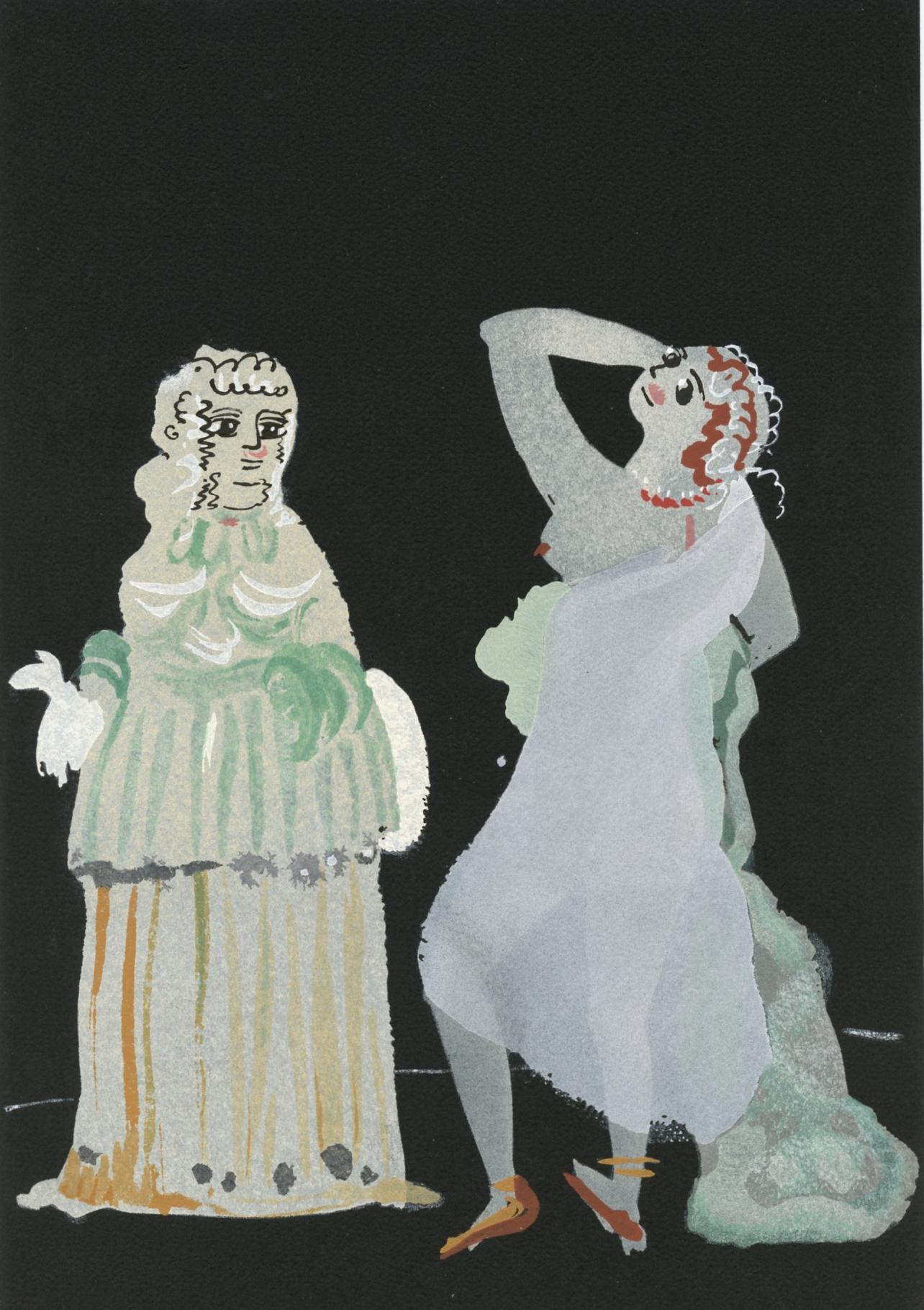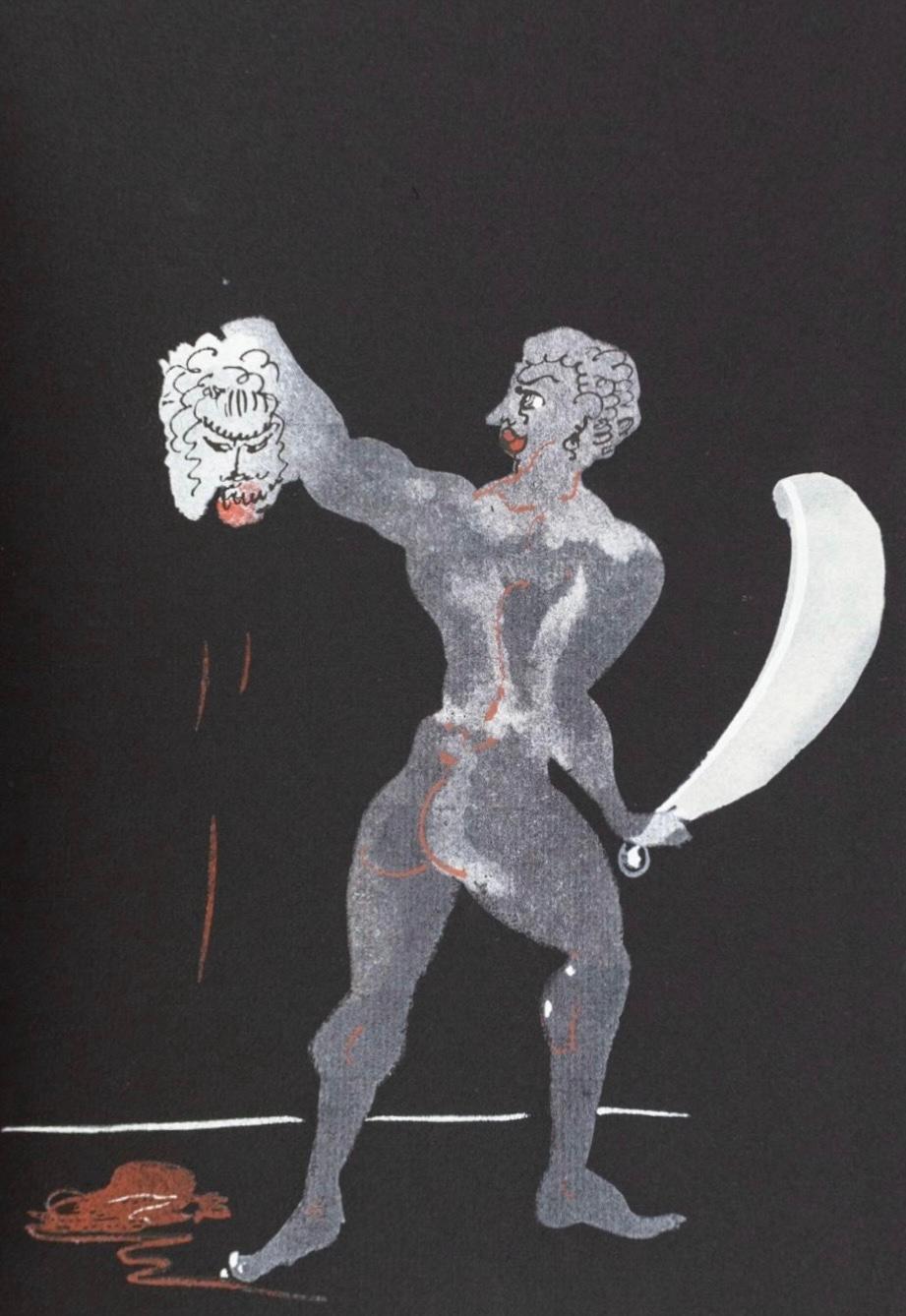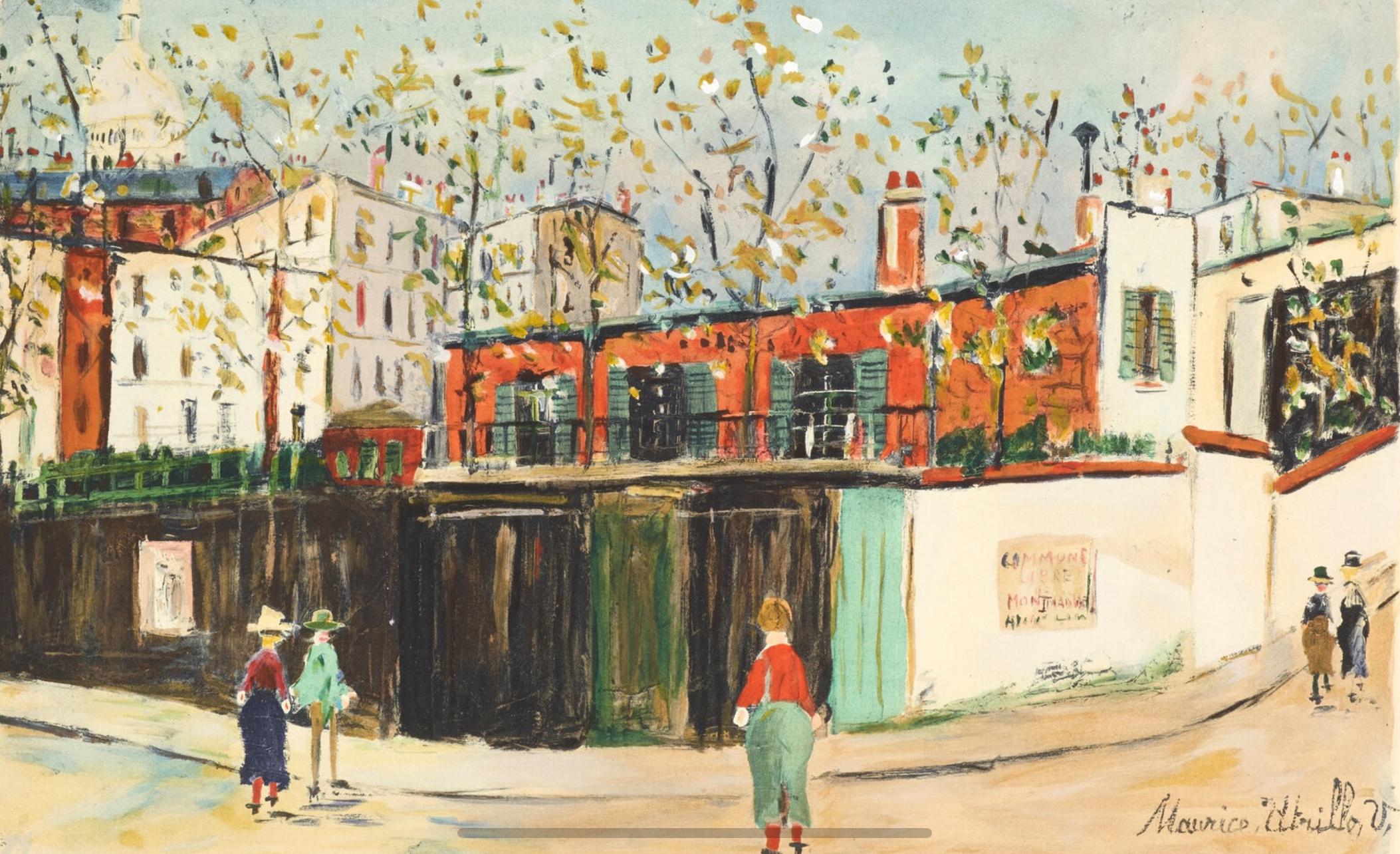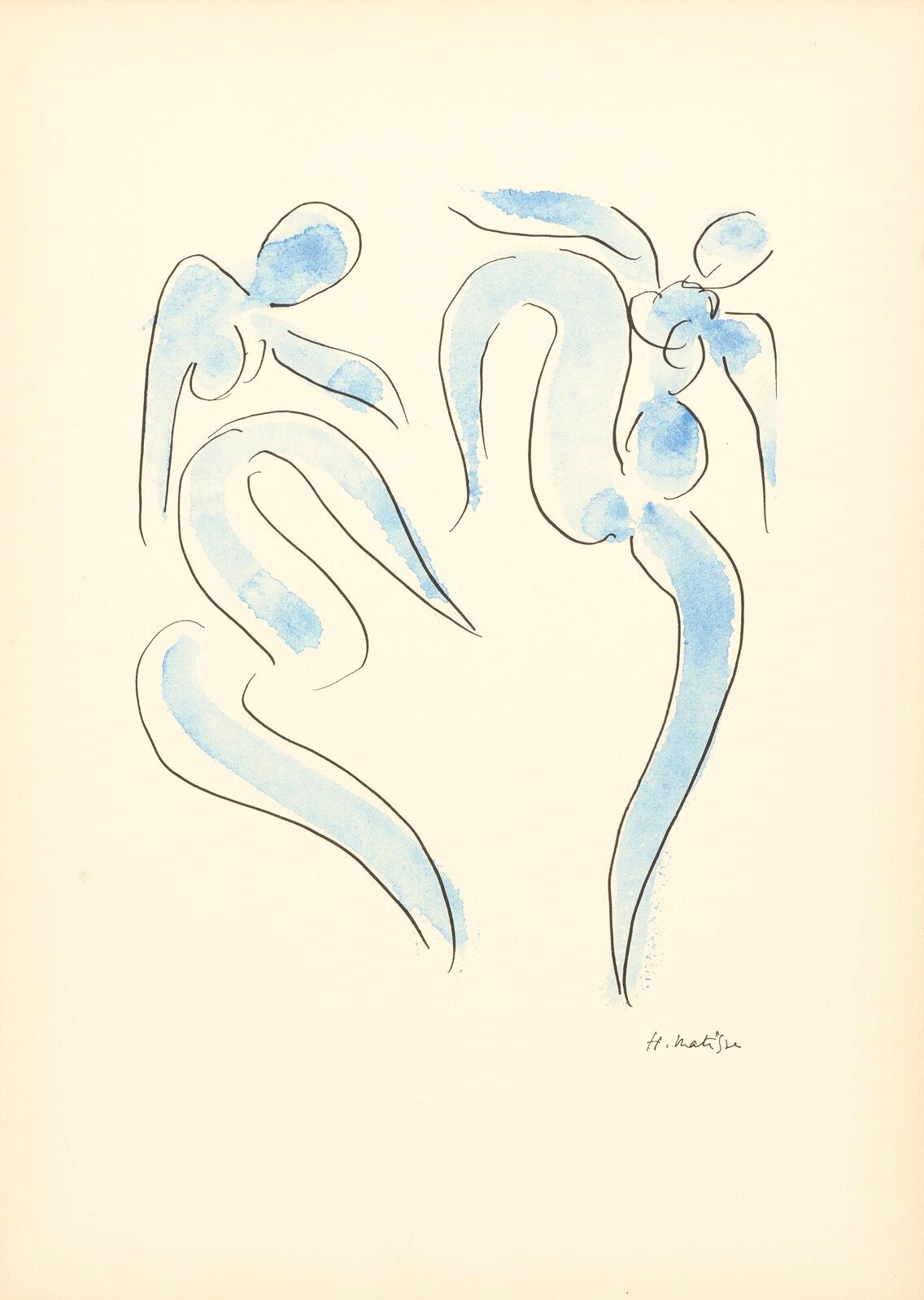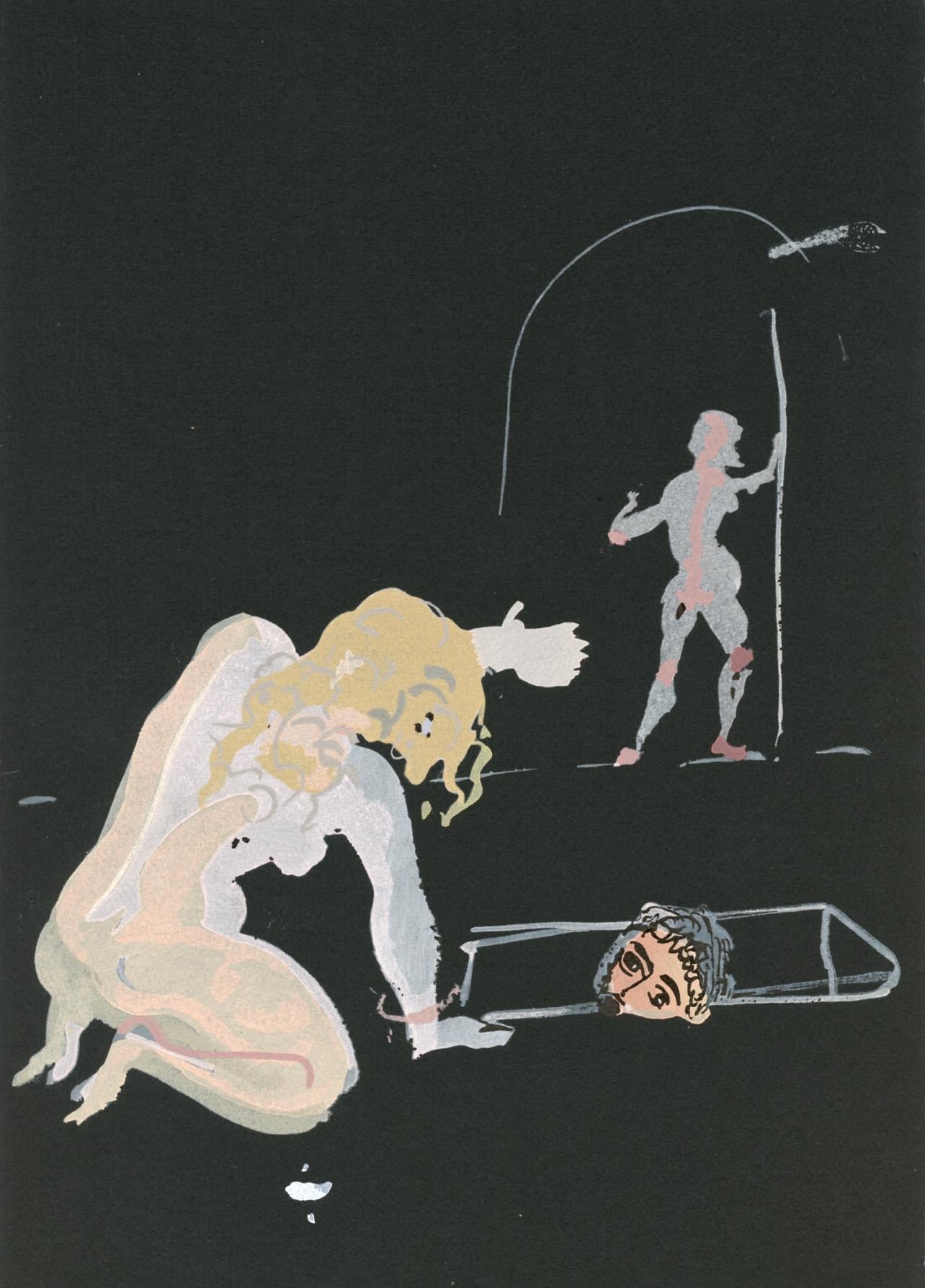Items Similar to Derain, Composition, Salomé, The Limited Editions Club (after)
Want more images or videos?
Request additional images or videos from the seller
1 of 9
Derain, Composition, Salomé, The Limited Editions Club (after)1938
1938
About the Item
Lithograph, Stencil on wove paper. Inscription: Unsigned and unnumbered. Good condition. Notes: From the volume, Salomé published by The Limited Editions Club, Paris; rendered by Jean Saudé, Paris; printed by Dehon et Cie, Faubourg-Saint-Denis, Paris, 1938. Excerpted from the volume, This edition of Salomé, printed in the original French as Oscar Wilde wrote it, consists of fifteen hundred copies for the members of the Limited Editions Club. It is designed by René Ben Sussan and printed by Dehon et Cie. In the Faubourg-Saint-Denis, Paris, the type being a new face designed by A.M. Cassandre, called Peignot and set by hand. The illustrations are gouache drawings on black paper by André Derain
reproduced through the pochoir process by Saudé in Paris. Excerpted from The Monthly Letter of The Limited Editions Club, July 1938, Number 110, On the left bank of the river which winds through Paris, behind the Boulevard Saint-Germain upon the sidewalks of which the French artists and American tourists sip their apéritifs and watch other French artists and other American tourists passing by, there is an historic little street. It is not a street in the broad sense at all, it is a narrow alley not twenty paces long, comprising two pairs of houses, their facades stained by the centuries, facing each other over cobbled stones worn smooth by the centuries. It is called the Cour de Rohan. You go into the second house on the right through a door which opens directly upon an chormous room; a room with a worn board floor, high ceilings, windows which look out on the cobbled stones, and no furniture whatever, not a chair not a table not a lamp, only a great artist's castle and a flat low model's throne. In this room Messieurs Danton and Marat met to plan the overthrow of the French aristocracy. In this room Monsieur Guillotin spread a paper over a desk and sketched the efficient machine which later cut off the heads of the French aristocracy. And in this room we cm-barked upon the exciting adventure of creating for you our members a new edition of Salomé. We dian't know at the moment that it would prove an exciting adventure; we didn't know, when we first told you about it in the prospectus for our Ninth Scries, how exciting the adventure would prove. This month your copy of Salomé is going to you and we now tell you about the adventure. It was André Derain who started it. He is an enormous hulk of a man. He is one of the most famous painters in the world. But he was not intended to be. He was born in 188o, in a little place called Chatou near Paris. His father was a superlative pastry cook, who therefore intended André to be an engincer. But, when André was only nine-teen, he met Maurice de Vlaminck, a man thirty years his senior who proceeded to interest him in painting and in painting like Cézanne. He went to Paris to study, and for years turned out paintings under the influence of Gauguin and Van Gogh and Cézanne. The art critics now call this his Gothic period, for he used the color schemes of the Gothic era and the Italian primitives such as Giotto and Cimabue. But then he came into contact with the works of Matisse and Picasso and their friends. These painters were called les fauves, because even their followers thought of them as wild animals. After the war, however, he broke away from their influence and came under the spell of the art of Renoir. Derain is now considered a painter whose design is rhythmical and finely balanced, with a range of color deliberately restricted. There have been exhibitions of the paintings of André Derain in New York and Cincinnati and Chicago as well as in all the principal cities of Europe. There have been nine books written about his life and works, one by Elie Faure in 1923. At this moment, his paintings are in even greater demand than the paintings of Picasso and Matisse. These paintings are hung in nearly all the principal mu-scums of the world. And Monsieur Derain has also illustrated books. That is why we went to see him, in his bare and historic studio in the Cour de Rohan. We wanted him to illustrate Prosper Merimée's Carmen, because we wanted him to make pictures of the female figure. He didn't like that idea, he said he was not interested in the period and the costumes required for a series of proper illustrations to Carmen. Then we suggested twelve other books. Then he suggested fourteen other books. Suddenly there was a dramatic pause, he lifted his enormous bulk off the window sill, he pointed a portentous finger at us, and he said: Salomé. So we said All right, little knowing the excitement of the adventure we were embarking upon. After we had gone through the delightful formality of signing a contract with André Derain, whereby he undertook to make a series of illustrations for Salomé by Oscar Wilde, we thought it would be a fine thing to have the edition printed in Paris, but printed in the English language. We did not know what would happen when we went across the Channel to London, to met with Holbrook Jackson. Mr. Holbrook Jackson is a kindly English gentleman, who edits a chain of trade papers for the world of the nineteen thirties but himself lives in the eighteen nineties. He is an authority upon the 'nineties, he knows with exactly what impatience John Lane greeted Aubrey Beardsley when Beardsley came to see him in his new shop in Vigo Street; he knows exactly how Oscar Wilde turned his back when he passed the Marquis of Queensberry in the street. His own book about the eighteen nineties is fascinating reading. We went to him, to ask him to write an introduction for our edition of Salomé. Before we left him, we knew more about the writing of Salomé than we ever thought we would know. We will tell you what we learned: When Oscar Wilde wrote Salomé, he was at the height of his powers. The year was 18g1, a year in which he published four books, The Picture of Dorian Gray, Intentions, Lord Arthur Savile's Crime and A House of Pomegran.
ANDRE DERAIN (1880-1954) had a major role in the development of two of the most significant artistic movements of the early-20th century. He, Henri Matisse, and Maurice de Vlaminck were responsible for generating works with a totally new style which would become Fauvism and his association with Pablo Picasso and Georges Braque was integral to early Cubism. Nevertheless, his contribution as the generator of the ideas behind these movements is constantly debated, and some consider his work derivative. This is due in part to the fact that, continually in search of artistic meaning and attempting to create a timeless art removed from the specificity of the modern age, he experimented with different stylistic idioms. Whichever side of the Derain debate you end up on, we can all appreciate his use of expressive vibrant color, his simplification of form, and his fascination with primitive art were constants throughout his work and played a major role in the creation and propagation of early Modern Art.
- Creation Year:1938
- Dimensions:Height: 11 in (27.94 cm)Width: 7.5 in (19.05 cm)
- Medium:
- Movement & Style:
- After:André Derain (1880-1954, French)
- Period:
- Condition:
- Gallery Location:Auburn Hills, MI
- Reference Number:1stDibs: LU1465214327612
About the Seller
4.9
Gold Seller
These expertly vetted sellers are highly rated and consistently exceed customer expectations.
Established in 2002
1stDibs seller since 2021
869 sales on 1stDibs
Typical response time: 1 hour
- ShippingRetrieving quote...Ships From: Clinton Township, MI
- Return PolicyA return for this item may be initiated within 1 day of delivery.
Auctions on 1stDibs
Our timed auctions are an opportunity to bid on extraordinary design. We do not charge a Buyer's Premium and shipping is facilitated by 1stDibs and/or the seller. Plus, all auction purchases are covered by our comprehensive Buyer Protection. Learn More
More From This SellerView All
- Derain, Composition, Salomé, The Limited Editions Club (after)By André DerainLocated in Auburn Hills, MILithograph, Stencil on wove paper. Inscription: Unsigned and unnumbered. Good condition. Notes: From the volume, Salomé published by The Limited Editions Club, Paris; rendered by Jea...Category
1930s Modern Abstract Prints
MaterialsLithograph, Stencil
- Derain, Composition, Salomé, The Limited Editions Club (after)By André DerainLocated in Auburn Hills, MILithograph, Stencil on wove paper. Inscription: Unsigned and unnumbered. Good condition. Notes: From the volume, Salomé published by The Limited Editions Club, Paris; rendered by Jea...Category
1930s Modern Abstract Prints
MaterialsLithograph, Stencil
- Matisse, La danse, Douze Contemporains (after)By Henri MatisseLocated in Auburn Hills, MILithograph, stencil on wove paper. Inscription: Unsigned and unnumbered. Good condition. Notes: From the folio, Douze Contemporains, 1959; published by Éditions d'Art du Lion, Paris;...Category
1950s Modern Abstract Prints
MaterialsLithograph, Stencil
- Utrillo, Montmartre, Douze Contemporains (after)By Maurice UtrilloLocated in Auburn Hills, MILithograph, stencil on wove paper. Inscription: Unsigned and unnumbered. Good condition. Notes: From the folio, Douze Contemporains, 1959; published by Éditions d'Art du Lion, Paris;...Category
1950s Modern Abstract Prints
MaterialsLithograph, Stencil
- Derain, Composition, Salomé, The Limited Editions Club (after)By André DerainLocated in Auburn Hills, MILithograph, Stencil on wove paper. Inscription: Unsigned and unnumbered. Good condition. Notes: From the volume, Salomé published by The Limited Editions Club, Paris; rendered by Jea...Category
1930s Modern Abstract Prints
MaterialsLithograph, Stencil
- Derain, Composition, Salomé, The Limited Editions Club (after)By André DerainLocated in Auburn Hills, MILithograph, Stencil on wove paper. Inscription: Unsigned and unnumbered. Good condition. Notes: From the volume, Salomé published by The Limited Editions Club, Paris; rendered by Jea...Category
1930s Modern Abstract Prints
MaterialsLithograph, Stencil
You May Also Like
- Oceanic Batik, 1926 - Original LithographLocated in Paris, FRE.H. Raskin Oceanic Batik, 1926 Original lithograph and stencil Printed signature in the plate On paper, 37,5 x 27,5 cm (c. 14,7 x 10,8 inch) INFORMATION : This lithograph is part ...Category
1920s Art Deco Abstract Prints
MaterialsLithograph, Stencil
- Oceanic Flowers, 1926 - Original LithographLocated in Paris, FRE.H. Raskin Oceanic Flowers, 1926 Original lithograph and stencil Printed signature in the plate On paper, 37,5 x 27,5 cm (c. 14,7 x 10,8 inch) INFORMATION : This lithograph is par...Category
1920s Art Deco Abstract Prints
MaterialsLithograph, Stencil
- Pablo Picasso Estate Hand Signed Cubist Lithograph Abstract Woman Portrait TeteBy (after) Pablo PicassoLocated in Surfside, FLPablo Picasso (after) "Femme Assise dans un Fauteuil" limited edition print on Arches paper, Hand signed by Marina Picasso lower right and numbered 284/500 lower left From the estat...Category
20th Century Modern Abstract Prints
MaterialsLithograph
- French Modernist Mourlot Lithograph Vintage Air France Poster Roger BezombesBy Roger BezombesLocated in Surfside, FLVintage French Travel Poster, Air France Roger Bezombes (1913-1994) French Bezombes was a painter, sculptor, medalist, and designer. He studied in Paris, at the École des Beaux-Arts, and was much influenced by his friendship with Maurice Denis. Heavily influenced by surrealism, He worked principally as a painter, adopting the saturated Fauvist colors of Henri Matisse in landscapes and figure studies often based on observation of “exotic” cultures, notably Mediterranean and North African. Constrained, because a very young orphan, to all kinds of professions which provide him with the material means to devote himself to painting - he participated in 1930 in the installation of the exhibition of the Bauhaus at the Grand Palais-, Roger Bezombes is student of the National School of Fine Arts in Paris. (Ecole des Beaux Artes) He was trained in the art of fresco by Paul Baudoüin, René Barotte nonetheless restores that the young man's preference goes to the practice of "truancy" which he uses to make copies at the Louvre Museum. It’s the time when Paul Gauguin’s paintings, Vincent Van Gogh and Henri Matisse are revealed to him by Maurice Denis with whom he will remain close until his accidental death, painting him on his funeral bed on November 14, 1943. He executed surrealist tapestry designs for Aubusson and Gobelin tapestries, posters (winning the Grand Prix de l'Affiche Francaise in 1984), costumes and sets for ballets at the Metropolitan Opera House in New York, reliefs and murals. In 1965 he took up medal-making, expressing in his numerous metallic works for the Paris Mint that obsession with found objects which is also evident in his large-scale sculpture and in his posters. He designed posters for Air France and for the French national railways. Roger Bezombes went to Africa for the first time in 1936 thanks to a travel grant and received the same year the second grand prize of Rome . In 1937 he traveled around Morocco where he became friends with Albert Camus. The year 1938 offered him both his first solo exhibition at the Charpentier gallery in Paris with paintings and gouaches on the theme of Morocco and the attribution of the national grand prize for the arts, earning him a great journey which , from Dakar to Algiers , takes it through Chad , Tamanrasset and Hoggar. Roger Bezombes became a professor at the Julian Academy in 1950. For him, 1951 was the year of a trip to Greece and the year where he began his relationship with tapestry work. Roger Bezombes visited Israel in 1953, Tunisia and Egypt in 1954. He was appointed official painter of the Navy in 1955. Pierre Mazars analyzes that “after a period where we notice the influence of Van Gogh and GeorgesBraque, particularly in his landscapes of Provence, he came to a more schematic writing, the colored spots and the thicknesses of material taking more of importance as the subject. He even performed composite works, half-watercolors, half-pasted papers, in which he incorporated pieces of newspapers”. He was elected titular to the Academy of Overseas Sciences in 1978. "The range of Bezombes' talent forms is remarkable,” writes Lynne Thornton, “ranging from paintings, murals, travel posters, tapestry cartons, book illustrations, monumental ceramic decorations, ballet and theater sets, totem sculptures, sculpture objects, jewelry and medallions”. He was part of the mid century mod School of Paris that included Leon Zack, Bernard Lorjou, Paul Augustin Aizpiri, Gabriel Godard, Michel Henry, Hans Erni, Bengt Lindstrom, Alfred Manessier, Andre Hambourg, Raymond Legueult and Jean Rigaud. Select Solo Exhibitions: 1938: Galerie Charpentier, Paris 1950, '53, '55, '57: Galerie Andre Weil, Paris 1953:Wildenstein Gallery, London 1954: Institut Francais, Cologne 1956: Galerie Matarasso, Nice 1957: Horn Gallery, Luxembourg; Guilde de la Gravure, Paris 1958: Denys-Puech Museum, Rodez 1962: Musee de l'Athenee, Geneva; Chateau Grimaldi, Cagnes-sur-Mer 1966: Galerie des Ponchettes, Nice 1967: Galerie Martel, Montreal 1968: Romanet-Vercel Gallery, New York; Reattu Museum, Arles; Le Corbusier Center, Firminy 1969: Galerie Philippe...Category
1980s Modern Abstract Prints
MaterialsOffset, Lithograph
- French Modernist Mourlot Lithograph Vintage Air France Poster Roger BezombesBy Roger BezombesLocated in Surfside, FLVintage French Travel Poster, Air france Roger Bezombes (1913-1994) French Bezombes was a painter, sculptor, medalist, and designer. He studied in Paris, at the École des Beaux-Arts, and was much influenced by his friendship with Maurice Denis. Heavily influenced by surrealism, He worked principally as a painter, adopting the saturated Fauvist colors of Henri Matisse in landscapes and figure studies often based on observation of “exotic” cultures, notably Mediterranean and North African. Constrained, because a very young orphan, to all kinds of professions which provide him with the material means to devote himself to painting - he participated in 1930 in the installation of the exhibition of the Bauhaus at the Grand Palais-, Roger Bezombes is student of the National School of Fine Arts in Paris. (Ecole des Beaux Artes) He was trained in the art of fresco by Paul Baudoüin, René Barotte nonetheless restores that the young man's preference goes to the practice of "truancy" which he uses to make copies at the Louvre Museum. It’s the time when Paul Gauguin’s paintings, Vincent Van Gogh and Henri Matisse are revealed to him by Maurice Denis with whom he will remain close until his accidental death, painting him on his funeral bed on November 14, 1943. He executed surrealist tapestry designs for Aubusson and Gobelin tapestries, posters (winning the Grand Prix de l'Affiche Francaise in 1984), costumes and sets for ballets at the Metropolitan Opera House in New York, reliefs and murals. In 1965 he took up medal-making, expressing in his numerous metallic works for the Paris Mint that obsession with found objects which is also evident in his large-scale sculpture and in his posters. He designed posters for Air France and for the French national railways. Roger Bezombes went to Africa for the first time in 1936 thanks to a travel grant and received the same year the second grand prize of Rome . In 1937 he traveled around Morocco where he became friends with Albert Camus. The year 1938 offered him both his first solo exhibition at the Charpentier gallery in Paris with paintings and gouaches on the theme of Morocco and the attribution of the national grand prize for the arts, earning him a great journey which , from Dakar to Algiers , takes it through Chad , Tamanrasset and Hoggar. Roger Bezombes became a professor at the Julian Academy in 1950. For him, 1951 was the year of a trip to Greece and the year where he began his relationship with tapestry work. Roger Bezombes visited Israel in 1953, Tunisia and Egypt in 1954. He was appointed official painter of the Navy in 1955. Pierre Mazars analyzes that “after a period where we notice the influence of Van Gogh and GeorgesBraque, particularly in his landscapes of Provence, he came to a more schematic writing, the colored spots and the thicknesses of material taking more of importance as the subject. He even performed composite works, half-watercolors, half-pasted papers, in which he incorporated pieces of newspapers”. He was elected titular to the Academy of Overseas Sciences in 1978. "The range of Bezombes' talent forms is remarkable,” writes Lynne Thornton, “ranging from paintings, murals, travel posters, tapestry cartons, book illustrations, monumental ceramic decorations, ballet and theater sets, totem sculptures, sculpture objects, jewelry and medallions”. He was part of the mid century mod School of Paris that included Leon Zack, Bernard Lorjou, Paul Augustin Aizpiri, Gabriel Godard, Michel Henry, Hans Erni, Bengt Lindstrom, Alfred Manessier, Andre Hambourg, Raymond Legueult and Jean Rigaud. Select Solo Exhibitions: 1938: Galerie Charpentier, Paris 1950, '53, '55, '57: Galerie Andre Weil, Paris 1953:Wildenstein Gallery, London 1954: Institut Francais, Cologne 1956: Galerie Matarasso, Nice 1957: Horn Gallery, Luxembourg; Guilde de la Gravure, Paris 1958: Denys-Puech Museum, Rodez 1962: Musee de l'Athenee, Geneva; Chateau Grimaldi, Cagnes-sur-Mer 1966: Galerie des Ponchettes, Nice 1967: Galerie Martel, Montreal 1968: Romanet-Vercel Gallery, New York; Reattu Museum, Arles; Le Corbusier Center, Firminy 1969: Galerie Philippe...Category
1980s Modern Abstract Prints
MaterialsLithograph, Offset
- Fernand Leger Colorful Modernist Drawing Limited Edition Serigraph LithographBy (after) Fernand LégerLocated in Surfside, FLSerigraph, from ''Album of Ten Serigraphs'' (1954-55), by Fernand Leger (French 1881-1955), signed and dated in plate lower right, printed by Jean Bruller, distributed by Galerie International de la Gravure, Paris (Sapphire E8), sheet: 22''H x 15''W, "Chevreuse Aout", Serigraph in colors on Arches paper, F. Leger embossed blindstamp, Numbered in pencil and bears the embossed stamp. Joseph Fernand Henri Léger (French 1881 – 1955) was a French painter, sculptor, and filmmaker. In his early works he created a personal form of cubism which he gradually modified into a more figurative, populist style. His boldly simplified treatment of modern subject matter has caused him to be regarded as a forerunner of pop art. Léger was born in Argentan, Orne, Lower Normandy, where his father raised cattle. Fernand Léger initially trained as an architect from 1897 to 1899, before moving in 1900 to Paris, where he supported himself as an architectural draftsman. After military service in Versailles, Yvelines, in 1902–1903, he enrolled at the School of Decorative Arts after his application to the École des Beaux-Arts was rejected. He nevertheless attended the Beaux-Arts as a non-enrolled student, spending what he described as "three empty and useless years" studying with Gérôme and others, while also studying at the Académie Julian. He began to work seriously as a painter only at the age of 25. At this point his work showed the influence of impressionism, as seen in Le Jardin de ma mère (My Mother's Garden) of 1905, one of the few paintings from this period that he did not later destroy. A new emphasis on drawing and geometry appeared in Léger's work after he saw the Cézanne retrospective at the Salon d'Automne in 1907. In 1909 he moved to Montparnasse and met Alexander Archipenko, Jacques Lipchitz, Marc Chagall, Joseph Csaky and Robert Delaunay. In 1910 he exhibited at the Salon d'Automne in the same room (salle VIII) as Jean Metzinger and Henri Le Fauconnier. In his major painting of this period, Nudes in the Forest, Léger displays a personal form of Cubism that his critics termed "Tubism" for its emphasis on cylindrical forms. In 1911 the hanging committee of the Salon des Indépendants placed together the painters identified as 'Cubists'. Metzinger, Albert Gleizes, Le Fauconnier, Delaunay and Léger were responsible for revealing Cubism to the general public for the first time as an organized group. The following year he again exhibited at the Salon d'Automne and Indépendants with the Cubists, and joined with several artists, including Le Fauconnier, Metzinger, Gleizes, Francis Picabia and the Duchamp brothers, Jacques Villon, Raymond Duchamp-Villon and Marcel Duchamp to form the Puteaux Group—also called the Section d'Or (The Golden Section). Léger's paintings, from then until 1914, became increasingly abstract. Their tubular, conical, and cubed forms are laconically rendered in rough patches of primary colors plus green, black and white, as seen in the series of paintings with the title Contrasting Forms. Léger made no use of the collage technique pioneered by Georges Braque and Pablo Picasso.As an enthusiast of the modern, Léger was greatly attracted to cinema, and for a time he considered giving up painting for filmmaking. In 1924, in collaboration with Dudley Murphy, George Antheil, and Man Ray, Léger produced and directed the iconic and Futurism-influenced film Ballet Mécanique (Mechanical Ballet). Neither abstract nor narrative, it is a series of images of a woman's lips and teeth, close-up shots of ordinary objects, and repeated images of human activities and machines in rhythmic movement. In collaboration with Amédée Ozenfant he established a free school where he taught from 1924, with Alexandra Exter and Marie Laurencin. He produced the first of his "mural paintings", influenced by Le Corbusier's theories. His varied projects included book illustrations, murals, stained-glass windows, mosaics, polychrome ceramic sculptures, and set and costume designs. He was active as a teacher for many years, first at the Académie Vassilieff in Paris, then in 1931 at the Sorbonne, and then developing his own Académie Fernand Léger, which was in Paris, then at the Yale School of Art and Architecture (1938–1939), Mills College Art Gallery in Oakland, California during 1940–1945, before he returned to France. Among his many pupils were Hananiah Harari, Asger Jorn, Michael Loew, Beverly Pepper, Marcel Mouly, Louise Bourgeois, Tsuguharu Foujita, Sam Francis, Serge Gainsbourg, Hans Hartung, Florence Henri, Asger Jorn, William Klein, Maryan, Jules Olitski, Erik Olson...Category
1950s Modern Abstract Prints
MaterialsLithograph
Recently Viewed
View AllMore Ways To Browse
The Stone By The Door
Picasso Signed Sketch
Picasso The Artist And His Model
Andre Derain
John Andre
Picasso Costume
Le Fauves
Vintage Furniture Stencils
Editing Desk
House Number Window
Van Gogh Book
The Painter And His Model Picasso
Vintage Sidewalk
Vintage Watches London
Vintage Pastry
Period Fauvism Painting
Painting Andre Derain
Set Matisse Prints
